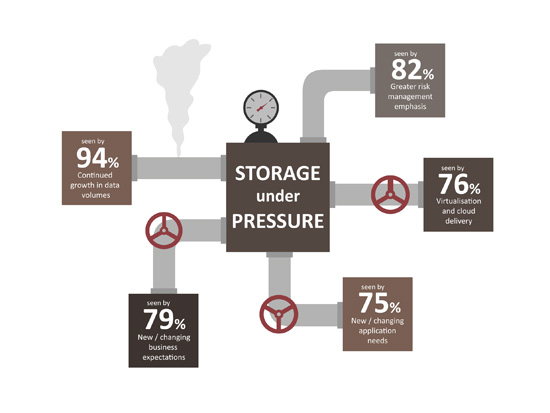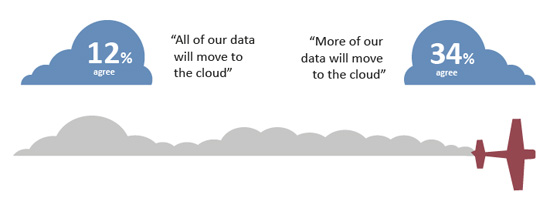The chances are that your storage systems are subject to a range of pressures, almost any of which could prompt a rethink on how you deliver services to your customers and users. While data growth is clearly a significant factor in nearly all cases, this isn’t the only trend creating challenges.
Four out of every five organisations providing feedback in a recent study [1], for example, also highlight risk management, escalating business expectations, and new demands arising from virtualisation and other technology-related developments as having a significant impact (Figure 1).
Figure 1
Against this background, many vendors, analysts and commentators have positioned cloud storage as a potential way forward for enterprises. But is this really the answer to dealing with all future storage needs? The study suggests not, with the vast majority of IT professionals working in data centres clearly not regarding cloud to be a universal magic bullet (Figure 2).
Figure 2
But this doesn’t mean that cloud storage doesn’t have its place. As we can see, just over one in three respondents state that more of their data will move to cloud services over time, with around one in eight agreeing that all of their data will ultimately live in a cloud provider’s data centre.
If you are one of those who see the potential for cloud storage, what use cases could be considered as suitable targets?
A few have already found a place in some organisations, the most obvious of which is to store data which is essentially ‘born in the cloud’, i.e. data created by other cloud services that has never been held inside an enterprise data centre. Indeed the analysis of cloud data is now well established, especially for looking at large data volumes to analyse areas such as customer sentiment and behaviour etc., especially where the data originates from social cloud services.
A second use case involves adopting cloud storage as a repository for data that only needs to be held for a short time. One example is the now near proverbial ‘test/dev’ scenario where there is a requirement for resources to test a new application using existing, hopefully properly masked, enterprise data. Rather than acquire infrastructure, including potentially large amounts of storage, some organisations use cloud resources that are just paid for when they are needed. This use now appears to be well on the road to becoming mainstream.
Another reasonably well developed use for cloud storage is centred on data protection. Indeed some vendors and their channel partners have already started building solid business streams around cloud backup and recovery. To further expand the attractiveness of such solutions they are sometimes expanded into ‘hybrid solutions’ where backup data is held on site in a dedicated cache or repository prior to being replicated offsite to a cloud service.
The hybrid approach is especially popular to help address some of the challenges inherent in moving large volumes of data over the internet. This can be a particular problem for smaller companies where available network capacity may be limited. It can also be valuable in order to be able to restore significant data volumes rapidly, perhaps in the case of a server rebuild or to roll back to an instance of a data base that was protected prior to an episode of data corruption.
An extension of data protection that has seen real world adoption are cloud services providing data archiving capabilities. In the past archiving has often been restricted to data sets that have some element of external compliance dictating their long term storage. However, there is a good case for data archiving to become more important as data volumes continue to ramp up and organisations expect to hold on to data for ever longer timeframes.
Several archiving business models have been brought to market. One provides data capacity with very low storage costs per Gigabyte but which may also entail charges each time data is retrieved. Other models offer a flat fee per Gigabyte of data stored but also include the ability to search and retrieve data without additional charges being incurred.
The first approach is well suited to data sets that will be accessed or retrieved rarely, essentially long term cold storage. The second offering is better for an archive where users are expected to search for data relatively frequently and may wish to retrieve it on a more routine basis. This usage model is now often referred to as an ‘active archive’, and is one several vendors are promoting. Essentially the archive becomes more of an offsite data store where information is held, searched, shared and used regularly rather than a location where data is sent to be held only for exceptional circumstances.
The net is that cloud storage is not the answer to all storage challenges, nor is it likely to become so in the foreseeable future. But there are some use cases that make sense for certain organisations, whether exploiting public cloud resources or those provided on a restricted hosted private basis.
[1] STORAGE under PRESSURE. The use of modern technologies to alleviate the strain
Tony is an IT operations guru. As an ex-IT manager with an insatiable thirst for knowledge, his extensive vendor briefing agenda makes him one of the most well informed analysts in the industry, particularly on the diversity of solutions and approaches available to tackle key operational requirements. If you are a vendor talking about a new offering, be very careful about describing it to Tony as ‘unique’, because if it isn’t, he’ll probably know.







Have You Read This?
From Barcode Scanning to Smart Data Capture
Beyond the Barcode: Smart Data Capture
The Evolving Role of Converged Infrastructure in Modern IT
Evaluating the Potential of Hyper-Converged Storage
Kubernetes as an enterprise multi-cloud enabler
A CX perspective on the Contact Centre
Automation of SAP Master Data Management
Tackling the software skills crunch